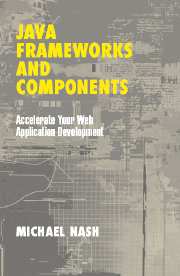Book contents
- Frontmatter
- Contents
- Acknowledgments
- 1 Components and Application Frameworks
- 2 Components: The Future of Web-Application Development
- 3 Application Frameworks: What Do They Provide and What Are the Benefits?
- 4 Choosing an Application Framework
- 5 A Catalog of Application Frameworks
- 6 Comparing Frameworks
- 7 Open Source and Components/Frameworks
- 8 Development Methodologies and Design Patterns
- 9 Integrated Development Environments
- 10 Strategies for Using Frameworks: Best Practices
- 11 Conclusions: The Future of Frameworks and Components
- Appendix: Case Studies
- Glossary
- Index
5 - A Catalog of Application Frameworks
Published online by Cambridge University Press: 28 July 2009
- Frontmatter
- Contents
- Acknowledgments
- 1 Components and Application Frameworks
- 2 Components: The Future of Web-Application Development
- 3 Application Frameworks: What Do They Provide and What Are the Benefits?
- 4 Choosing an Application Framework
- 5 A Catalog of Application Frameworks
- 6 Comparing Frameworks
- 7 Open Source and Components/Frameworks
- 8 Development Methodologies and Design Patterns
- 9 Integrated Development Environments
- 10 Strategies for Using Frameworks: Best Practices
- 11 Conclusions: The Future of Frameworks and Components
- Appendix: Case Studies
- Glossary
- Index
Summary
In this chapter, we will take a brief look at a number of more popular and extensive Web application frameworks. It is not our intention to reproduce the frameworks' own documentation here: you may refer to the appropriate website for each framework for technical and user documentation. What we want to do is observe the frameworks as examples of Web application building frameworks in general, and to outline their major capabilities. Each framework has its strengths and weaknesses, which we will explore in detail later when we compare frameworks in Chapter 6.
Many of these frameworks would take an entire book to fully explore, so what we discuss here is just an outline of what they have to offer. A large number of frameworks are open-source projects, and are actively under development – so it is important to see what has changed and what is new when you review the framework yourself.
You will not find here an evaluation of the framework. It is not possible to judge the suitability of a framework for your particular task without the knowledge of a great many factors, some of which we will explore in Chapter 6, where we will show how to match up the problem with the potential solutions and choose a suitable framework for your task. There are no absolute measures by which we can say this framework is “better” than some other one – you must decide that based on your requirements.
- Type
- Chapter
- Information
- Java Frameworks and ComponentsAccelerate Your Web Application Development, pp. 131 - 214Publisher: Cambridge University PressPrint publication year: 2003



